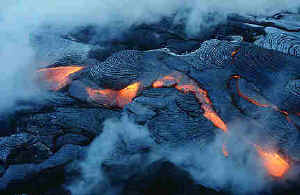|
Early humans could not imagine where rocks came from.
They could describe the physical features of a rock but it was difficult
to determine where rocks came from. Rocks that formed through the action
of water were observed early on. Since sedimentary rocks are the most
common on the surface of the Earth, it was easy for people to make this
connection.
Geologists even up to the early 1800's believed
that all rocks crystallized from oceanic water. Even volcanic eruptions
were thought to be burning of coal seams beneath a volcanic vent.
Eventually the "Neptunists" or people who believed that all
rocks came from water, were replaced by geologists who witnessed
volcanic activity. An expedition around 1730's to Iceland, watched lava
flows from fissures in the Earth, was the evidence that
Plutonists (scientists who believed that volcanic rocks were from within
the Earth) needed to dispel the theories of the Neptunists.
|

Lava flow from Hawaii

Kenya, Africa
|